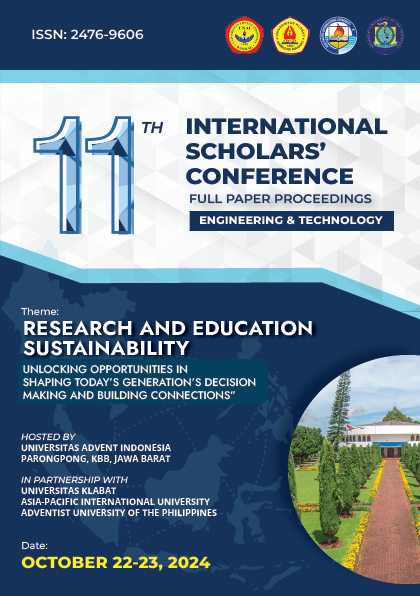Design and Optimization of a Bio-Composter System Using Genetic Algorithm
Keywords:
Genetic algorithm, NPK, Optimization, Composter, FertilizerAbstract
The Philippine agricultural sector's reliance on costly imported chemical fertilizers creates economic burdens and compromises long-term sustainability. To address this, organic composting provides a local, eco-friendly alternative, but its success relies on achieving consistent, high-quality compost. This study aimed to design and construct a small-scale composter system that utilizes Genetic Algorithm in the quality optimization of composter operational parameters and integrate monitoring and remote capabilities. The study specifically aimed to develop an optimization model using a genetic algorithm to a) to determine the best composter operational parameters for each compost material (soy pulp, vegetable peelings, coffee grounds) and b) to maximize composting efficiency, minimize resource usage and enhance overall sustainability of the system. The resulting NPK values of each compost material were compared to the commercialized fertilizer. The genetic algorithm achieved realistic results in determining the best composter operational parameters for each compost material with the given target NPK(Nitrogen, Phosphorus, Potassium) values. Findings demonstrated that increased runtime significantly improves compost quality, while optimal rotation speed yields diminishing returns beyond a certain threshold. Composter system software also provided ease of use through an interface for composter control and monitoring systems. To further improve the system, integration of advanced automation and upgrading the motor power capabilities are recommended.
Downloads
References
(BSWM), B. o. (2021). Enhancing Compost Quality through Technology Integration. BSWM Journal of Soil Management.
(IRRI), I. R. (2021). Innovative farming solutions to increase productivity in Philippine rice farming. Retrieved from https://ati2.da.gov.ph/ati-car/content/article/bongbong-l-buli-e/enhancing-productivity-through-innovative-rice-farming-techniques-aews
Agriculture, P. D. (2020). Philippine Agriculture in 2020: Status, Challenges, and Policies. Retrieved from https://pidswebs.pids.gov.ph/CDN/PUBLICATIONS/pidspn2112.pdf
Authority, P. S. (2020). Fertilizer statistics in the Philippines, 2018. Philippine Statistical Reports on Agriculture and Fisheries.
Chun-Fang Shi, H.-T. Y.-T.-P.-Y.-B.-G.-M. (2022, August). Optimization of Humic Acid Content in GLR Composting. Bioresource Technology, 357, 127248.
Composting. (2014, February 3). Retrieved from Town of North Castle. NY: https://www.northcastleny.com/sites/g/files/vyhlif3581/f/file/file/composting.pdf
Crisostomo, J. (2018). Economic impacts of high fertilizer prices in the Philippines. Journal of Southeast Asian Economies, 35(3), 355-367.
David, C. C., & Inocencio, A. B. (2019). The state of Philippine agriculture: Challenges for sustaining productivity growth. Philippine Review of Economics, 56, 95-122.
Grell, M., Barandun, G., Asfour, T., Kasimatis, M., Collins, A. P., Wang, J., & Güder, F. (2021). Point-of-use sensors and machine learning enable low-cost determination of soil nitrogen. Nat Food 2, 981-989.
Guochao Ding, X. S. (2023). The Influence of a CGA-BP Neural-Network-Based Aeration Oxygen Supply Prediction Model on the Maturity of Aerobic Composting. Processes, 11(6), 1591.
Kim, M.-S., Kim, S.-C., Yun, S.-G., Park, S.-J., & Lee, C.-H. (2018). Quality Characteristics of Commercial Organic Fertilizers Circulated. Journakl of the Korea Organic Resources Recycling Association, 26(1), 21-28.
Kumar, S., Bharti, A., & Kumar, R. (2020). Composting parameters and compost quality: a literature review. Environmental Technology & Innovation, 2020, Article 101026. doi:10.1016/j.eti.2020.101026
Li, M., Li, S., Chen, S., Meng, Q., Wang, Y., Yang, W., . . . Guo, X. (2023). Measures for Controlling Gaseous Emissions during Composting: A Review. International Journal of Environmental Research and Public Health, 20(4), 35-87.
Malik, A. &. (2023). Advances and applications of genetic algorithms in machine learning for materials science. Materials Today: Proceedings, 62, 6692-6698. .
Schmitt, J., Bönig, J., Borggräfe, T., Beitinger, G., & Deuse, J. (2020). Predictive model-based quality inspection using Machine Learning and Edge Cloud Computing. Advanced Engineering Informatics, 45.
Schorr, S., Möller, M., Heib, J., Fang, S., & Bähre, D. (2020). Quality Prediction of Reamed Bores Based on Process Data and Machine Learning Algorithm: A Contribution to a More Sustainable Manufacturing. In Procedia Manufacturing (Vol. 43, pp. 519-526).
Downloads
Published
How to Cite
Issue
Section
License
Copyright (c) 2024 11th International Scholars Conference

This work is licensed under a Creative Commons Attribution-ShareAlike 4.0 International License.
Copyright © 2024 ISC Committee.















